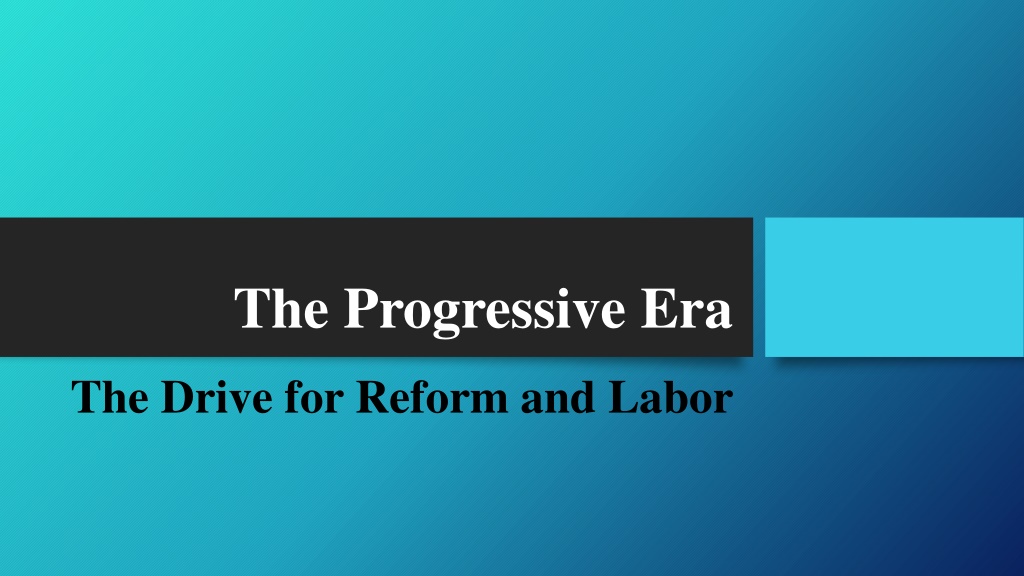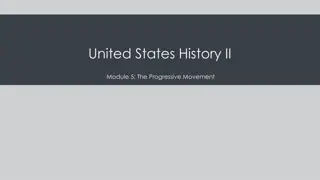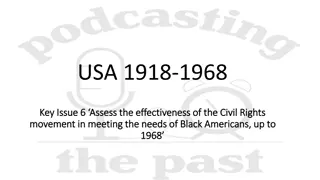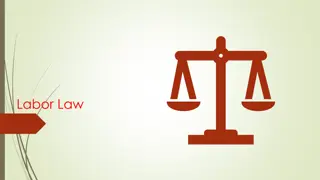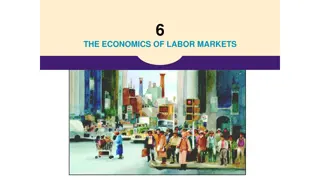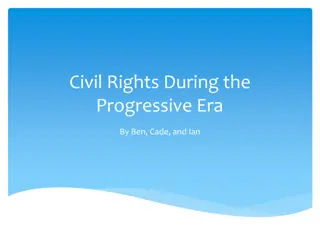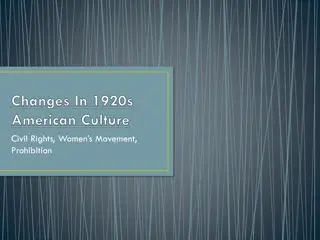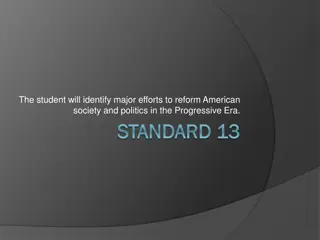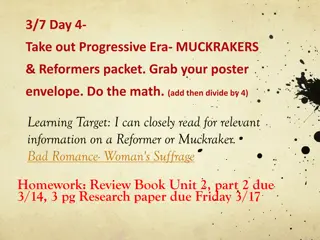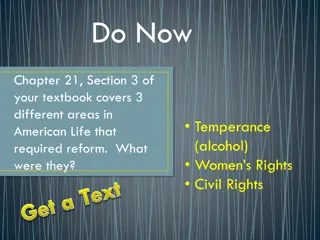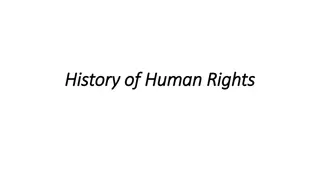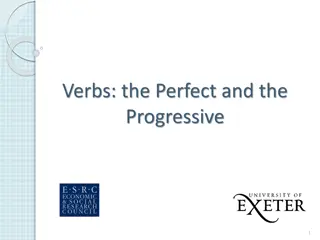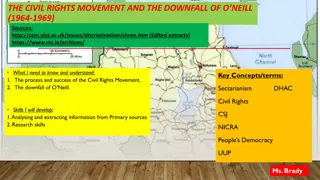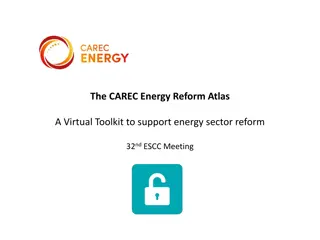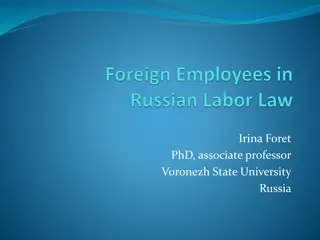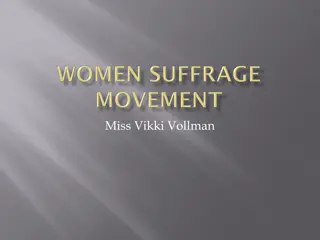The Progressive Era: A Movement for Social Reform and Labor Rights
The Progressive Era emerged in the late 19th century as a response to the challenges brought by industrialization, urbanization, and immigration. Progressives aimed for social justice through political reforms, honest governance, and curbing the power of big businesses. The movement drew individuals from various backgrounds, with a shared goal to address the issues faced by workers and society at large.
Download Presentation

Please find below an Image/Link to download the presentation.
The content on the website is provided AS IS for your information and personal use only. It may not be sold, licensed, or shared on other websites without obtaining consent from the author. Download presentation by click this link. If you encounter any issues during the download, it is possible that the publisher has removed the file from their server.
E N D
Presentation Transcript
The Progressive Era The Drive for Reform and Labor
Origins of Progressivism Industrialization, urbanization, and immigration brought benefits and challenging social problems A movement called Progressivism (the belief that new ideas and honest, efficient government could bring about social justice) began in the 1890s
Origins of Progressivism Progressives came from all political parties, social classes, ethnic groups, and religions Many leaders came from the growing middle class Dissatisfied industrial workers also joined them movement as well as a few wealthy Americans drive by a desire to act in the public good
Sharing Common Beliefs Progressives shared a common belief in the problems created by industrialization and urbanization Wanted to bring about reforms that would correct social and political problems Wanted to get rid of corrupt government officials and make government more responsive to public needs Sought to eliminate the abuses of big business
Targeting a Variety of Problems Different progressives thought different issues were the most important Political reform For women, the right to vote Honest government Reforms of city life Big business reforms
Labor As industrialization grew, businesses relied more on workers, however struggles between owners and workers intensified Workers began rebelling against low pay and unsafe working conditions
Enduring Hardships Industrialization brought great wealth for owners of factories, mines, railroads, and large farms Brought higher standards of living, cheap goods, and access to public institutions like museums and schools The laborers struggled to survive
Factory Work Factory owners sought to increase profits by hiring workers willing to work for low wages (often immigrants) Worked long hours, usually six days a week Many women worked in sweatshops, which required them to work for long hours on machines
Factory Work Factory work often dangerous and accidents were common Despite harsh conditions, factories faced no labor shortage as there was always more people than jobs Since wages were low and women were working, many parents brought their children to keep them off the streets and to earn wages as well
Labor Unions Form Although industrialization did lower the price of goods, many factory wages were not enough to buy them Workers began taking their complaints directly to their employers Employers generally opposed the labor movement, seeing it as a threat to business and profits
Labor Unions Form As early as the 1820s, workers attempted collective bargaining (negotiating as a group for higher wages or better working conditions) Workers would strike, or refuse to work until certain demands were met First national labor union was founded in 1834: National Trades Union
Labor Unions Form Although first union did not last long, gradually national unions began to appear 1869: Uriah Smith Stephens founded the Knights of Labor, a union that allowed membership to anyone working in any trade, skilled or unskilled Operated as a secret society devoted to broad social reforms such as replacing capitalism with workers cooperatives
Labor Unions Form 1886: Samuel Gompers formed the American Federation of Labor (AFL) a craft union made up of skilled workers from some 100 local unions dedicated to craft or trade Set high dues to create a strike and pension fund Focused on specific workers issues such as wages, working hours, and working conditions Not as successful as the Knights because not as inclusive
Strikes First major strike occurred in the railroad industry in 1877 Striking workers, responding to wage cuts, caused massive property destruction in several cities State militias called in to protect strikebreakers and federal troops eventually called in to restore order
Haymarket Square Riot May 1, 1886: Thousands of workers mounted a national demonstration for an 8-hour workday Strikes erupted in cities and fights broke out between strikers and strikebreakers
Haymarket Square Riot May 4, 1886: Protesters gathered at Haymarket Square in Chicago A frenzy broke out when a protester threw a bomb killing a policeman Dozens of people were killed and four anarchists were executed Left an unfortunate legacy, Knights of Labor fizzled out as people shied away from radicalism and employers became even more suspicious of unions
Coal Creek Labor Saga In 1891 coal mine owners in Anderson County, Tennessee fired all of their miners and leased out convicts from the Tennessee to work in the coal mines For over a year, the displaced miners attacked and burned prison stockades and company buildings and many were killed in skirmishes
The Homestead Strike Summer of 1892 a Carnegie Steel plant cut workers wages, resulting in a strike Henry Frick, Carnegie s partner, responded by bringing in the Pinkertons (a private police force known for breaking up strikes)
The Homestead Strike Pinkertons killed several strikers and wounded others in a 2 week standoff Eventually, when public opinion began turning against the union, the union called off the strike in November During each strike, militia and troops were called in to suppress the unrest
Eugene Debs and Pullman In 1893, the Pullman Car Company laid off workers and reduced wages Owner of the company required workers to live in the company town and controlled their rents and prices of goods May 1894: workers sent representatives to negotiate with the company which resulted in the firing of 3 employees and shutting down the plant
Eugene Debs and Pullman Workers turned to the American Railway Union led by Eugene Debs Debs organized the ARU as an industrial union, grouping all railway workers together By June 1894, the ARU led a strike in which 300,000 railworkers had walked off their jobs
Eugene Debs and Pullman Pullman Strike escalated, halting both railroad traffic and mail delivery On July 4, President Cleveland sent in troops to break up the strike Debs was imprisoned for refusing to end the strike and though he appealed the governments authority to halt the strike, the Supreme Court upheld the ruling
Effects of the Labor Movement Outcome of Pullman set trends that employers would appeal for court orders against unions citing the Sherman Antitrust Act Federal government regularly approved these appeals Limited labor gains for more than 30 years Debs eventually became a socialist, running for President in 1900
